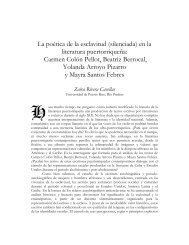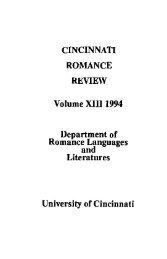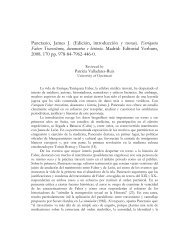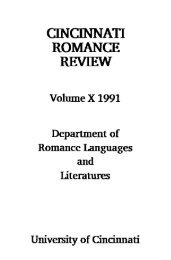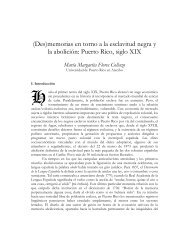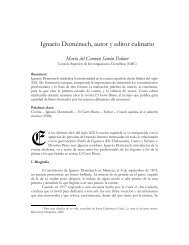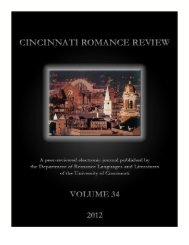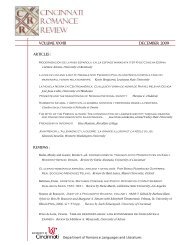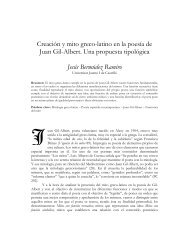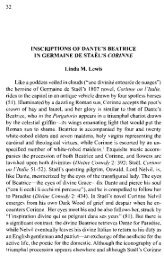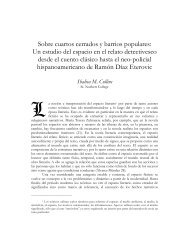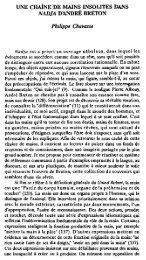Volume 30 (2011) - Cincinnati Romance Review
Volume 30 (2011) - Cincinnati Romance Review
Volume 30 (2011) - Cincinnati Romance Review
You also want an ePaper? Increase the reach of your titles
YUMPU automatically turns print PDFs into web optimized ePapers that Google loves.
WOMANISM AND SOCIAL CHANGE 123<br />
and communities are integrated too, sometimes subverting the original models. The<br />
emancipatory dances and words of Antígona have cultural references centered in<br />
Africa. 3 In that vein, Nah Dove emphasizes the concept of culture as a weapon of<br />
resistance and as a basis for defining a new world order (516). She indicates that, “Any<br />
future and continuing African liberationist theory and activism begins with the effort to<br />
recover, herstorically and culturally, the complementary relationship of the woman and<br />
the man as the basis for “ourstory” and self-determination. In this light, therefore,<br />
African womanism as Afrocentric theory takes on a central and critical role in that<br />
effort” (535). This coincides with Hudson-Weems call for Black women to define<br />
themselves and their critical perspectives and agenda in ways that reflect their particular<br />
experiences and African culture (34). Morgades’ selection of Antígona as the exemplar<br />
citizen and her performance as an African dancer and rebel underscore the importance<br />
of African women in the liberation of their societies.<br />
Transcultural Antígona<br />
The incorporation of African cultural elements to the play brings up the<br />
question of transculturation and the levels of fidelity of Morgades’ Antígona with the<br />
classical play. When asked about the genesis of her play, Morgades explained that “No<br />
por plagio ni por atrevimiento, sino por el asombro en pensar que la naturaleza humana<br />
no cambia y después de 2422 años, se puede traer a Sófocles y su época al Africa de<br />
nuestros tiempos revueltos” (Lewis 91), indicating how she has adapted classical<br />
Antigone to her culture of origin. By doing so she participates in a trend started by<br />
African theatre artists in the early 1960s that made popular Sophocles’ Theban cycle.<br />
According to critics there are several reasons for this popular movement. Barbara Goff<br />
and Michael Simpson explain that first, to adapt or transpose these plays is to reflect on<br />
the theme of identity, one of the most charged themes within anti-colonialist or<br />
postcolonial literature and theatre; second, they are appropriate to represent the<br />
postcolonial moment because these Greek dramas oscillate around the threshold of<br />
civilization; and finally, the re-readings the authors propose put at the center the issue of<br />
transmitting culture: “To change one of these icons is therefore to change, or at least<br />
challenge, the established notion of how these works, and all others, are ever presented<br />
to historical experience; it is also to propose alternatives to this dominant model of<br />
cultural transmission through time and of migration through space” (3). That is, they<br />
engage with the European canon, even as they also ultimate more indigenous traditions”<br />
(1-8). Kevin J. Wetmore highlights the fact that as with Greek tragedy, African theatre is<br />
community-based with a strong connection to ritual origins. The similarity of function<br />
______________________<br />
3 It is interesting that the same argument is used by Macias, but Morgades challenges his<br />
readings of what is “authentic African culture.”<br />
<strong>Cincinnati</strong> <strong>Romance</strong> <strong>Review</strong> <strong>30</strong> (Winter <strong>2011</strong>): 117-129.



